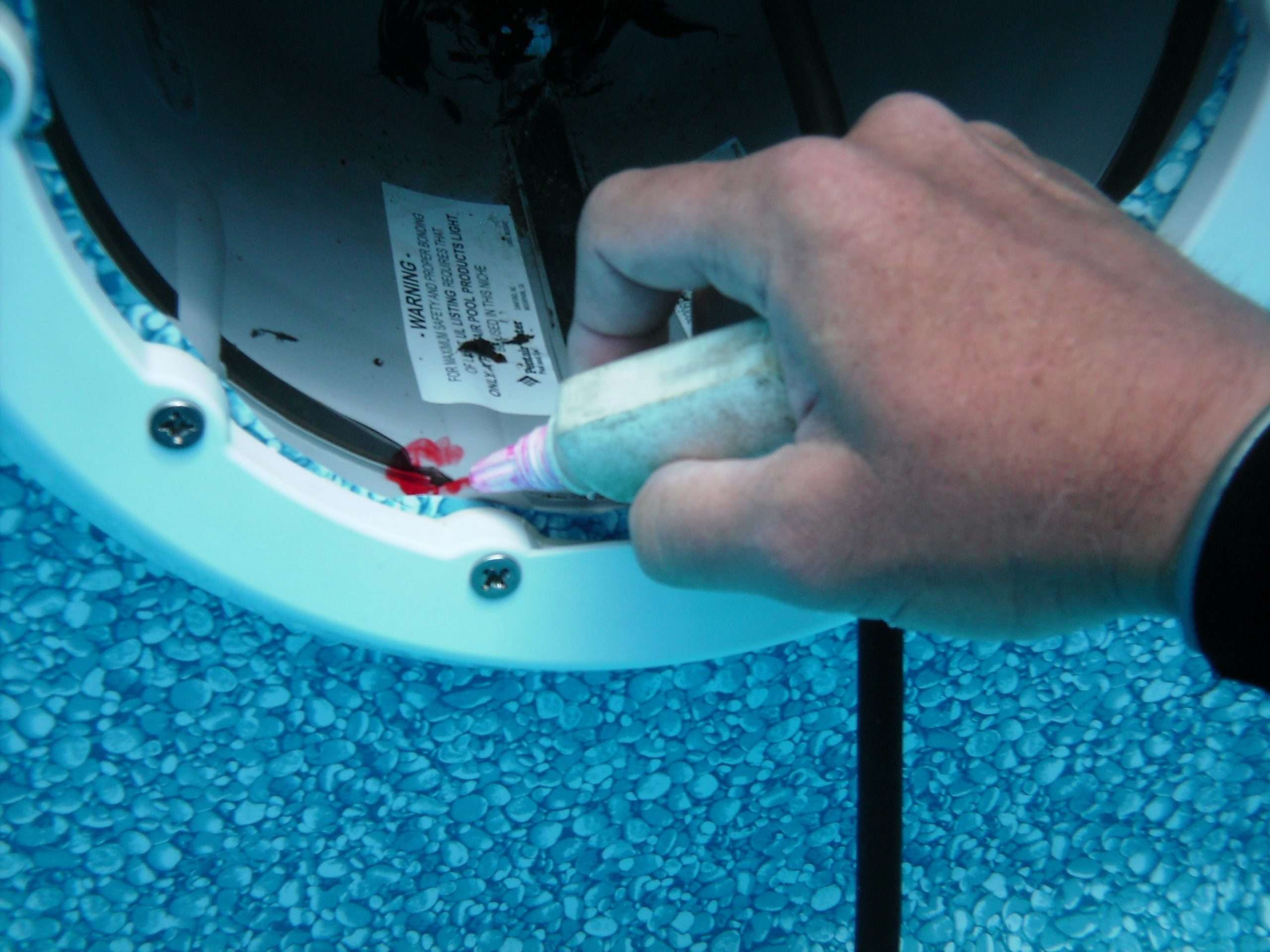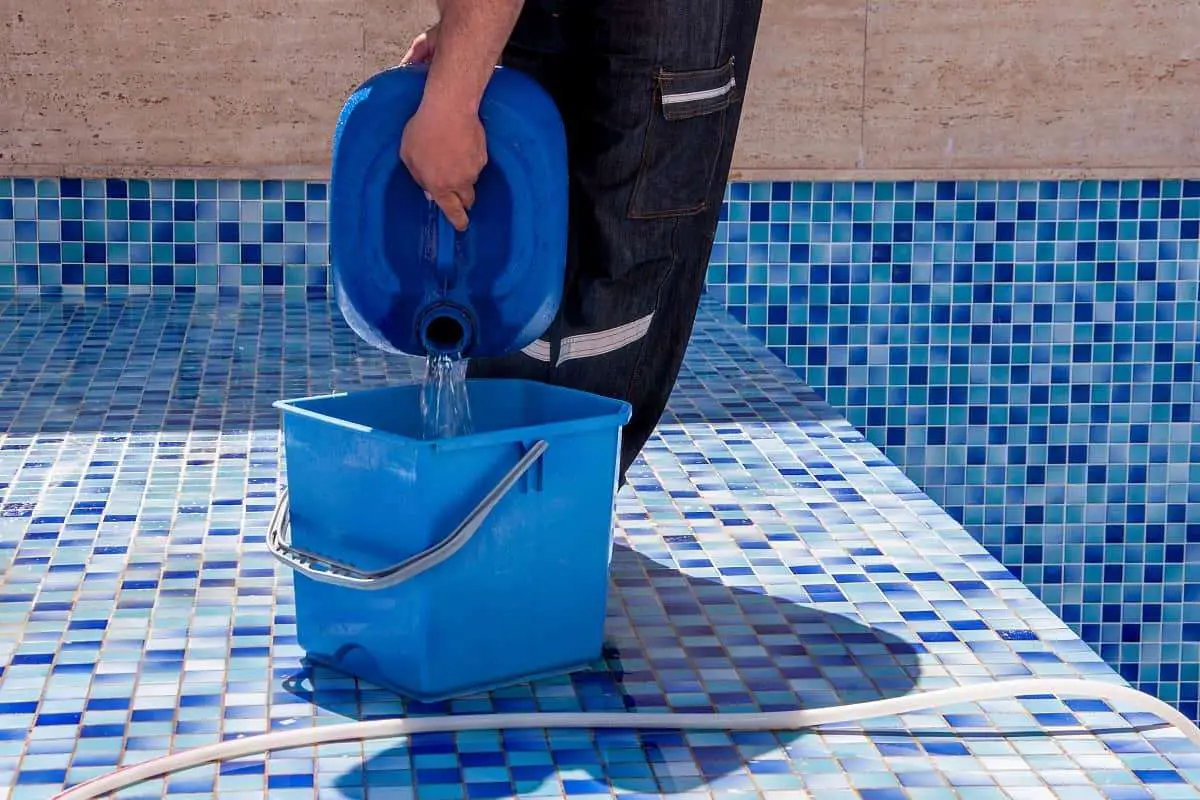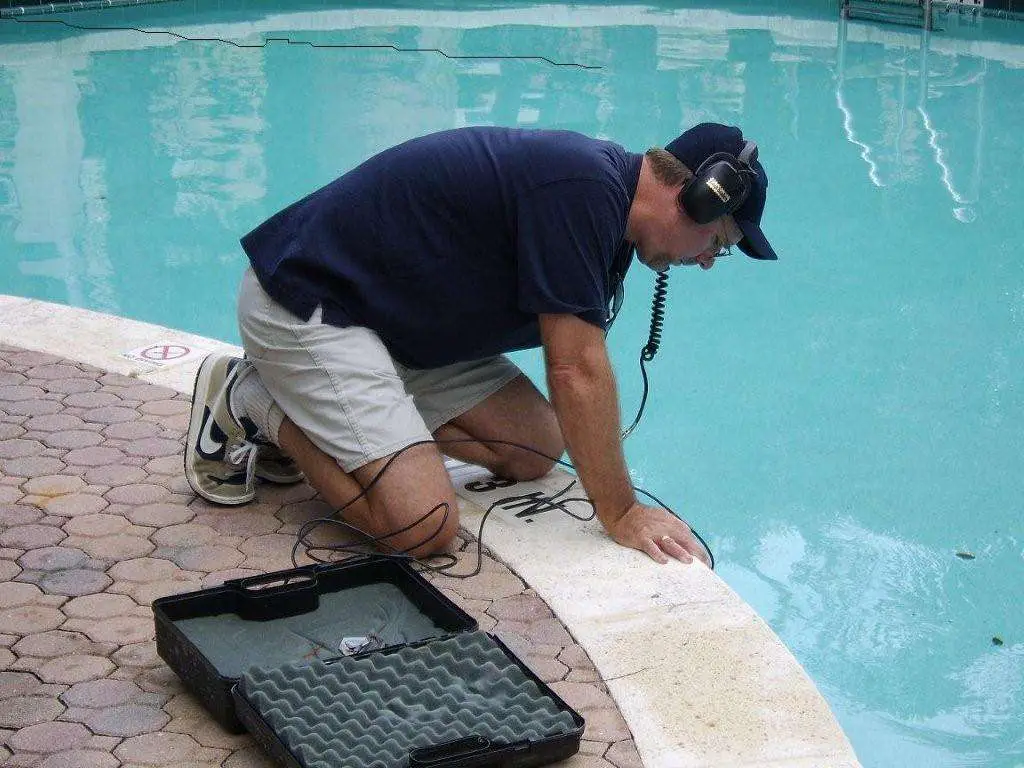Obvious Signs Of Damage
If your pool is leaking more than evaporating then the next step in the process of elimination is to thoroughly inspect the pool for damage. This is a step that an experienced pool technician will have a distinct advantage over a pool owner. There are many subtle symptoms that a pool is leaking in a specific spot. You may not even notice something minor that a more experienced eye may see. To combat this you must be very thorough when inspecting your pool for damage.Any part of your pool that shows signs of damage or wear is highly suspect when it comes to looking for pool leaks. When a pool leaks it will cause damage to the surrounding structures and some of this damage may be visible. Pool decks that are sinking or have cracks are a major symptom of a potential leak. Rust forming around skimmer and return ports, holes in your liner that have been patched, cracks in the pool floor, broken fittings – any signs of damage to the pool should be noted and heavily scrutinized to see if they are the cause of the leak or perhaps a symptom of a leak in an adjacent location. As an experienced pool leak detection expert this is the first thing that I am looking for when I inspect a leaking pool. In the event that you do discover some signs of damage, or you have an area that you suspect to be leaking, then the first step that you should take is to dye test this area.
Cover The Swimming Pool
Pool covers keep out dirt, leaves, flowers, pollen, insects, algae, birds, ducks, frogs and anything else that can invade your pool.
When all these contaminants enter your pool, you need more chemicals and filtering to remove them.
Install a pool cover.
It will be the best investment you ever made for your home. It will easily reduce your chemical, filtering and water requirements saving you the cost of the cover in no time.
How To Test If Your Pool Is Leaking
So, you’re filling your pool more often than normal. Is it a leak? And where’s it coming from? In this article we cover three basic leak tests. The “bucket test” will tell you if a drop in your pool water level is due to evaporation or a leak. The liner test will let you know if your liner’s sprung a leak. The third test will let you know if the leak is in your equipment or lines.
Also Check: Do It Yourself Swimming Pool
Wait 24 Hours & Check Results
Once everything is in place, its just a case of keeping your pool running under normal conditions for about a day. If, after 24 hours, the pool water level has decreased by the same amount as the bucket water level, you do not have a leak. However, if the pool water level has decreased more than the bucket water level, you probably have a leak.
Test #3the Equipment Connections Test

- 1If you have a sand filter, check the waste or backwash line to see if any water is escaping when the filter is set to filtration. If you see water, then a new filter head, filter head gasket, key assembly or other repair is probably required.
- 2Check the filter drain plugs, pump drain plugs and all connections after the pump. Check under the heater to see if water is leaking from underneath the heater. Check in and around the chlorinator to see if any water is visible. Repair leaks as required.
- 3If no leaks are found at the backwash line or at the equipment, consult Buds for options.
You May Like: Where To Buy Sustain Pool Chemicals
How To Test For A Leak In Your Inground Pool Piping
A pressure testing rig or stick is used to test individual lines, to see that they hold pressure. Experts will also introduce air into the pipe and listen for air escaping with high-tech headphones and a stethoscope of sorts. By doing this, professional leak detection companies can literally draw an X marking where to dig, whether it be in the yard or on your pools decking.
In most cases, a small 3×3 hole can be cut, and as the only leak detection and complete restoration company in the valley, Leak Science can legitimately find and fix the leak as if nothing ever happened.
The Swimming Pool Dye Test
If there is a location in your pool that you suspect is leaking, you can test that specific area with dye. Your goal in doing this test is to release a tiny amount of dye in the specific location where you suspect a leak.
When you conduct a pool dye test, make sure that your pool circulation system is turned off and that there is little or no wind causing movement in your pool water. Your pool water should be as still and as calm as possible when you do this test, so you are also required to be as still as possible as even putting your arm into the water can make the water move and the results of the test hard to assess.
To start the test, release a steady stream of dye into the area surrounding the suspected leak. Once you release the dye, it will tend to stay together and float gently with the subtle motion of the water moving. If there is a leak, you will see the dye being actively pulled out of the pool through the leak.
Dye testing is particularly useful around steps, skimmers, and lights. To detect a leak using this test, the key is to monitor the movement of the dye in the water. Take note, however, that cracks in your pool floor or in the main drain are not ideal for dye testing, unless you have scuba equipment that can allow you to get close enough to conduct the test in these areas.
Dye testers are used only as supplemental tools in leak detection, so dont expect the dye test to be a magic beacon pointing at your pool leak.
Read Also: Can I Paint The Concrete Around My Pool
How Much Water Loss Does A Pool Leak Create
Your pool will evaporate naturally, which is why it is important to understand the signs of a leaking pool. Most pool leaks start out small and gradually increase if gone undetected. There are many reasons a leak can start, but the average leak starts off fairly small.
A general rule of thumb is that if you lose more than 1/4 of an inch of water each day, then there is likely a leak. This would total of 1.5 inches of water loss each week, which would be on the high side of the spectrum. While 1/4 of an inch is a sign of a leak, 1/8 is considered average evaporation.
Such a small fraction of water loss is hard to eyeball, so you must learn how to determine if a leak has occurred.
How To Find Pool Leaks In Underground Pipes
Although you may not see them, pool leaks do occur in underground pipes. Due to them being invisible , most homeowners overlook them. They usually dont suspect a leak is even present until major issues arise. With major issues, comes costly repairs. That being said, we recommend all homeowners with an in-ground pool take the time to learn about how to look out for pool leaks in underground plumbing.
Recommended Reading: Can I Paint The Concrete Around My Pool
Clean The Skimmer Box
When the pump is operating the weir flap is open and pool water flows into the skimmer box.
The skimmer box contains a removable plastic filter basket that traps larger items of debris such as leaves, flowers and insects that are floating on the surface.
Empty the skimmer basket frequently to ensure free flowing water to the filter.
What To Do After Detecting A Leak
With these methods, you should have figured out where your pools leak is! However, pool leak detection is really just the start! You might now know that you have a leak, but you still need to fix it which can get quite expensive.
If your pools leak is in the liner or concrete, youre going to need to try to patch it up. Underground leaks are going to be a bit of a harder job.
If youre feeling up to the task, you can attempt this yourself. However, your pools entire plumbing is a bit of an expensive thing to risk as a DIY project. It could really go wrong if not handled correctly.
When the time comes to fix a leak, calling in a specialist is often the safest course of action. Pool maintenance teams are trained in finding and fixing pool leaks. This is a lot easier than trying to sit perfectly still underwater until the water stops moving, all while holding a bottle of dye.
More pool cleaning tips at YOUR tips:
You May Like: How Much Does A Salt Water Pool Cost
How To Test For Suction Side Air Leaks
One of the most aggravating areas of pool maintenance has to be water pressure issues. Whether these invisible gremlins rear their head in symptoms like your pump is not pushing water like it used, cant/loses prime, or air bubbles, it can be a real struggle finding the source. Lucky for you, there are a couple of really easy tricks to finding the source of a suction side air leak.
There are three popular, and more importantly simple ways for locating a sucking air leak, one using smoke, the soapy water, and lastly, shaving cream.
We suggest using the smoke method, aka The Smoke Trick, and for this step, youll need a lighter and some incense. With the pump running, light your incense, and slowly scan the stick over any PVC joints, valve ports, and covers, and pump housing. If the smoke gets drawn in, that will pinpoint the source of one of your leaks.
Smoke Method Steps:
Shaving Cream Method Steps:
Soapy Water Method Steps:
How To Fix A Leaking Pool Return Jet

Pool specialists cant deny the fact that weak pool jets are some of the most frequently reported problems.
Leaks in the pool return jets are commonly caused by broken fittings and poorly glued joints.
The solution to these is either to patch the crack around the fitting or replacing the broken pipe well as fitting, which is the most effective.
In this tutorial, well see how to patch or replace swimming pool return fittings.
You May Like: Vdara Escape Cabana
Is My Pool Leaking 4 Simple Steps To Check For Pool Leaks
Just imagine you walk into your backyard on a beautiful summer day, slip off your flip flops, and get ready to dive into the shimmering water of your pool.
But you hesitate because something doesnt look right. Is your pool water level lower than usual? Could there be a leak in your pool?
The first thing is to do is not panic! Although any leak should be repaired to maximize your pools energy efficiency, not to mention your enjoyment of it, its best to first make sure there actually is a leak.
If there is a leak, its a good idea to try and narrow down where it might be to minimize the time and cost it may take to repair it.
Finding A Pool Leak Quick Answers
While it is common for pools to lose a little water every day due to evaporation, excess water loss may indicate that you have a leak. Fixing those leaks quickly is key for pool maintenance but finding the exact source of a leak can be tricky. If you end up calling in a swimming pool leak detection professional, it can be pricey, too.
Fortunately, finding where your pool is leaking yourself is typically fast, easy, and much less expensive. Read on to learn how to find a leak in a pool with this complete guide. We address how to find a leak in all pool types such as fiberglass, plaster, concrete, and vinyl liners. Once you find the leak, here is our guide on how to fix a pool leak.
Recommended Reading: Concrete Sealer For Swimming Pools
Signs Of Leaking Pool Plumbing
Air Bubbles In Your Pool
Low water levels can cause air bubbles in your pool when your pump is running. This can be due to a variety of reasons but should be looked at further to rule out a leak.
Wet Spots In Yard
Have you noticed consistent wet spots in your yard? What about random patches of overgrown grass? Most assume its due to overwatered grass but you should also consider a pool leak being the cause. Water from a leaking pool pipe will eventually rise to the surface causing these stubborn wet spots. So before you blame yourself for overwatering, make sure to take a closer look.
Low Water Pressure
More air in your lines, means less water in your lines. The pressure gauge on your filter tells you where the water pressure is at. If it appears to be lower than normal, a pool leak in the plumbing is most likely the culprit. You can let some of the pressure out by using the filters air relief.
Cracks In Pool Decking
As water leaks from the pipes of your in-ground pool, it will begin to cause damage to surrounding areas. If you come across a crack in the decking surrounding your pool, a leak is usually present. Before it cracks, you may notice lingering wet spots in the decking. Take those as a sign of a leak and get it looked at before it has time to do more damage.
How To Dye Test For A Swimming Pool Leak
A dye test is one way to investigate swimming pool leaks. Red, yellow and blue dyes are used to find a swimming pool leak in the surface of a pool or spa tub. The red dye is the most common while a florescent yellow dye can be used for a dark painted surface. The blue dye is used on light colored pool surfaces.
Don’t Miss: Murray Outdoor Pool Hours
How To Find A Leak In In
A pool has two main plumbing systems: the suction system and the pressurized system.
The suction system pulls water from the pool and brings it back to the filter. The pressurized system pumps water back to the pool after it has passed through the filter. The filtered water returns through the jet inlets, often referred to as return plumbing.
Unfortunately, it can be difficult to determine what kind of leak you are dealing with until the pipe is excavated.
Pool Is Losing Water After Frequent Use
You might also just be losing water because youve been using your pool more. Lots of splashing around can force water onto your deck and into the air. If you only notice a drop in water level after a week of heavy pool use, there might not be a problem at all. If your filtration system requires backwashing maintenance, youre going to lose water during the process. Have you or your pool service company switched to a more frequent backwashing schedule? Is it time to replace your filter?
Also Check: How Much Is Salt Water Pool
Fixing Pool Liner Leaks
This method applies to above-ground vinyl liner pools. As long as the tear isnt too large, a temporary solution is to apply duct tape to the rip. You need to use a vinyl patch kit for a more permanent fix, which you can get from a local hardware or pool store.
These options are assuming you know how to use these repair materials. If you feel unsure, it is best to call in an expert. For vinyl pools, getting a patch kit is easiest . For larger repairs, read my full article on replacing a vinyl pool liner. For concrete pools, read my guide on pool plaster repair.
Ultimately, the critical thing to know is that any pool leak can be fixed and should not be a cause for panic. In most cases, you can fix the issue yourself without spending too much. By detecting a leak and applying the appropriate measures mentioned here, you should be able to enjoy your pool again.
Have questions? Send me a note, well be glad to help.
What Is The Difference Between A Concrete And A Gunite Pool

Concrete pools can be referred to as gunite pools, but what’s the difference?
Shotcrete pools are pools where the builder has the concrete mixed with water before and during the application. Concrete or shotcrete in this instance refers to wet mix concrete like concrete trucks. This may require someone to pour the concrete and is common for pool construction.
Gunite is concrete that is dry until applied. The builder would mix sand, cement, and water at the nozzle of a high-pressure applicator and spray the concrete. This is a highly durable material once cured. Again Gunite doesn’t require water until the pool installation crew is ready to spray the pool.
Recommended Reading: How To Convert Chlorine Pool To Saltwater Pool Cost